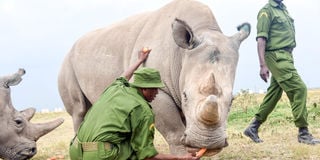Rhino numbers go up as efforts to fight poaching pay off

A caretaker feeds 19-year-old Fatu, one of the world’s last two Northern White Rhinos in Ol Pejeta Conservancy. Kenya is home to the last remaining two Northern White Rhinos in the world.
What you need to know:
- Six rhino species: Northern White Rhino (two), Black (5,500), White Southern (18,000), Greater One-Horned (3,500), Sumatran (78)and the Javan (68)
- This year, Kenya registered the birth of 45 rhinos
- There are only two existing in the world that are only found at the Ol Pejeta conservancy
Kenya’s black rhino population has doubled from less than 400 in 1985 to 794 by the end of 2019.
Kenya is home to the last remaining two Northern White Rhinos in the world. “But, the Northern White Rhinos are endangered. There are only two existing in the world that are only found at the Ol Pejeta conservancy. We are making sure the white rhinos are saved and we produce more. We must protect these animals,” said Tourism Cabinet Secretary Najib Balala during a webinar commemorating World Rhino Day last month.
This year, Kenya registered the birth of 45 rhinos.
“The white rhinos are not indigenous from Kenya, but the black ones are. We will save our rhinos through conservation, security, surveillance, resource mobilisation for the wildlife management post Covid-19 impacts and biological management to enhance its population and create more space for their breeding,” he said.
Globally, there are 27,200 rhinos. There are six rhino species including the Northern White Rhino (two), Black (5,500), White Southern (18,000), Greater One-Horned (3,500), Sumatran (78)and the Javan (68).
The CS said the ministry will provide sufficient and dedicated space for breeding the wildlife in different national parks across the country including Tsavo, Ruma, Nakuru, Meru and Aberdare.
Additional sanctuaries
“We must stamp out all illegal trade concerning rhinos and their horns to increase our numbers. We will further encourage and provide incentives to landowners to set aside suitable land to establish additional rhino sanctuaries,” he said.
Annually, the Kenya Wildlife Service uses Sh400 million to manage the sanctuaries and 1,000 rangers to protect its wildlife.
Globally, Kenya ranks fourth with the highest number of rhinos in the world after South Africa, Namibia and India.
The CS said poaching had been managed over the past three years.
However, the ministry is grappling with rhino deaths from other causes including predation, diseases and interspecies aggression
wildlife expert, Dr Rob Brett, praised Kenya’s success in increasing its black rhino population.



